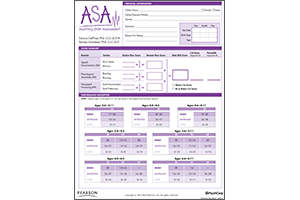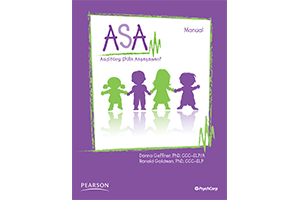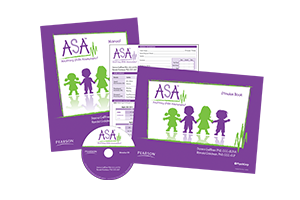|
Regarding auditory processing disorders (APD), which discipline should diagnose? In schools, they usually have the psychologist or audiologist make the CAPD diagnosis, even though we have tests as well.
|
|
Considering the various professional scopes of practice, the audiologist is best equipped to make the formal diagnosis of APD. However, in some districts there are no audiologists to do the testing and the SLP has the testing instruments to, at least, do screening. Under those circumstances, the SLP should complete an assessment and refer out to an audiologist for detailed testing if the SLP suspects APD. I suggest the SLP evaluate the child's listening comprehension skills, since a deficit in receptive language often looks like an APD. Further, since the SLP is the one who does the therapy, there is more than one role for the SLP, as usual. It is not an uncommon controversy—often I hear, "If the SLP does the therapy, why can't he or she diagnose the problem?" Again, this is a scope of practice and expertise issue. It would be best to work in tandem and have an audiologist consult in the assessment process, at a minimum. That said, I am not in favor of having a psychologist diagnose APD. I am familiar with their typical test instruments which can be used to classify APD, which looks at APD mainly from a processing standpoint of phonological skills. Diagnosing from that perspective alone is not always accurate. Again, working with the audiologist and the SLP will support the diagnostic process best.
|
|
Could you use the ASA with students who are English Language Learners (ELLs)—especially Spanish-speaking?
|
|
As with any assessment of a student who is learning English as a second language, best practice that you choose a combination of formal and informal measures in the primary language and use a process of gathering data across the settings of the student's life. The ASA could be used informally (i.e., without scores) if appropriate, especially the non-linguistic tasks.
|
|
If a child was never taught or exposed to phonological awareness tasks, is it ok to test anyway? Are these skills naturally there or do they have to be taught?
|
|
While oral language skills are "hard-wired" in the brain and typically developed through experience and the child's environment, written language skills must be taught. Phonological awareness tasks use oral language skills can be learned through oral language experience and practice. Some children learn sound awareness and manipulation skills easily in conversation and language play with others. However, many children need explicit instruction in phonological awareness as a precursor to written language instruction. In either case, the ASA can be used effectively even before direct instruction is given in phonological awareness.
|
|
If I work for a school district, how would the ASA fit—can it be considered a test that would help classify a child?
|
|
The ASA is a screening tool, and therefore is not an assessment to be used for eligibility purposes. The goal is early screening—which answers the question of risk status for deficits in auditory/listening skills. Certainly, screening data should be considered in the overall assessment process. The value of the early assessment helps keep the child "on the radar" and potentially benefit from an early intervention process, perhaps as in a Response to Intervention model.
|
|
How do you score Mimicry with a student who has very poor articulation?
|
|
Page 11 in the ASA manual states, "If you determine that an articulation error affected a response that was otherwise correct, you should score the response as correct; do not penalize a child for articluation errors. If a child has severe articulation errors and is unintelligible, these sections should not be administered. Record a total section raw score of 0 and continue to the next section."
|
|
Can an SLP treat a student for phonological tasks rather than the reading teacher?
|
|
Of course! Experts in reading and/or language have key training to support the phonological system in the development of reading. Depending on your particular setting and workflow, either or both disciplines may support phonological skill development in a particular child.
|
|
How much "noise" is needed for the testing in noise. Would it be done in the back of a classroom or in a hallway?
|
|
The background noise for Speech Discriminiation in Noise is provided by the ASA on the Stimulus CD. The examiner should provide a distraction-free environment, in a quiet, well-lit room. The background noise on the Stimulus CD is a conversation-based cafeteria noise with a +6dB signal-to-noise ratio (SNR).
|
|
How can I get the school district to use this test for every child enrolled in preschool for the 3 year old and older population?
|
|
You might position the use of the ASA as part of your annual vision and hearing screening efforts. The ASA is a perfect companion to the hearing screening process.
|
|
It sounds like many parts of this test can be used with older students to obtain clinical information—is that true?
|
|
Yes! You could choose to use the tasks from the ASA for older children descriptively. Of course, the normative data only go through 6:11.
|
|
Can you administer the ASA to a child who has a known speech and language delay?
|
|
You can. Keep in mind that if the delay is around articulation/phonology, you should follow the manual on scoring regarding these types of errors. Overall, children with speech and language delay were excluded from the normative sample because at this young age it would be difficult to discriminate language from auditory difficulties. See pages 11 and 24 in the manual regarding these two thoughts, respectively.
|
|
In order to score the ASA does the subject need to complete all subtests?
|
|
It depends on the age of the child. Younger children only complete Section 1: Speech Discrimination in Noise and Mimicry. Older children complete all six tasks.
|
|
What is a figure-ground listening skill deficit?
|
|
A figure-ground deficit is the inability to block out background noise and focus listening to the foreground (i.e., the speaker).
|
|
Could the ASA be an appropriate test for a child with cochlear implants?
|
|
Yes. If the child's cochlear implants are in good working order and the child passed a hearing acuity screening according to the specifications in the manual, the child may be administered the ASA descriptively.
|








